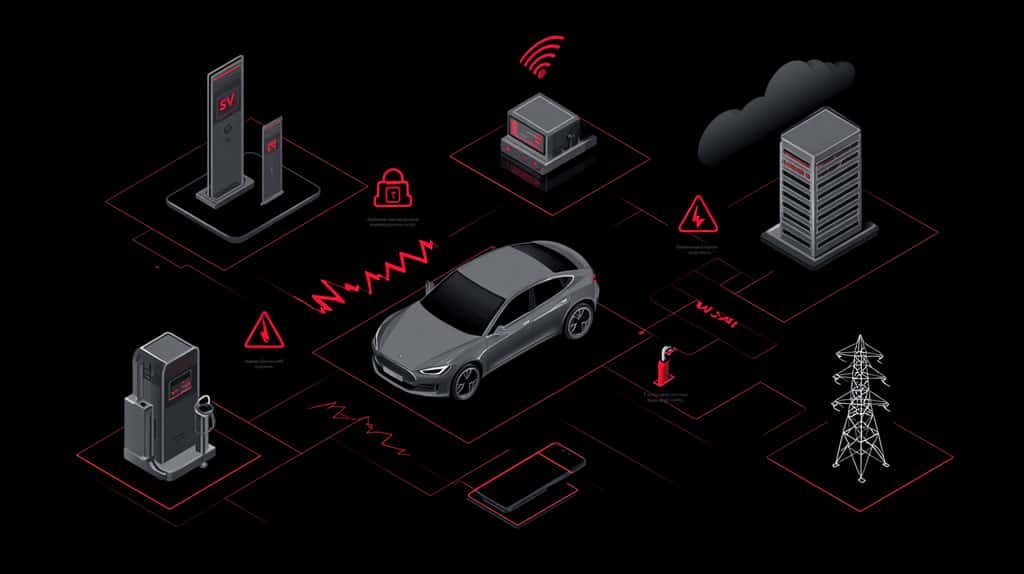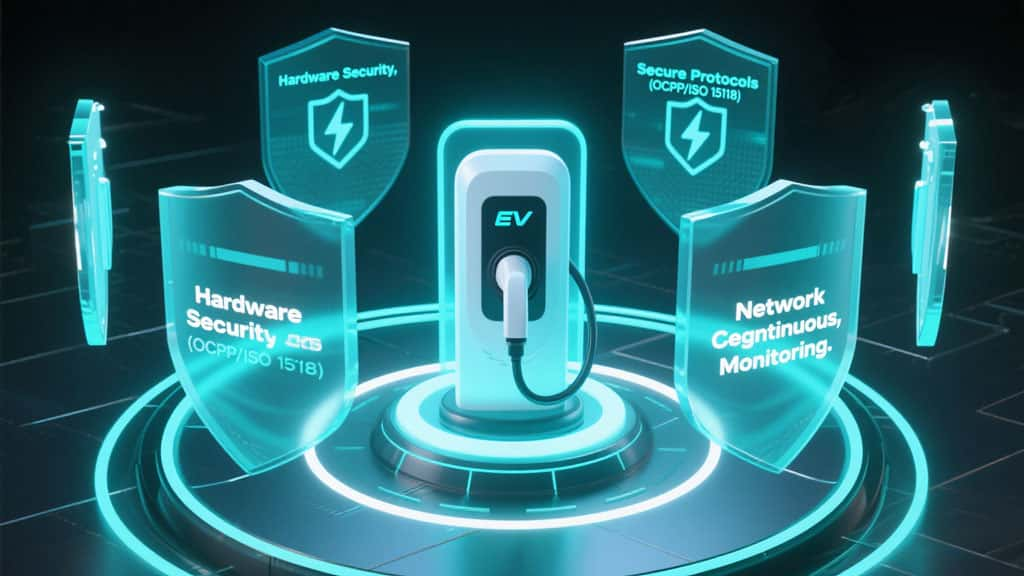To secure the rapidly expanding electric vehicle (EV) charging ecosystem, operators must adopt a multi-layered, proactive security framework. This approach moves beyond basic, reactive measures and integrates advanced technology, rigorous operational processes, and global regulatory compliance. The core solution involves implementing end-to-end encryption, adopting modern communication protocols like OCPP 2.0.1 and ISO 15118, enforcing strict access controls, and maintaining a continuous cycle of vulnerability scanning and penetration testing. By building security into the foundation of your network, you can protect your assets, safeguard customer data, and ensure the operational continuity that builds trust and drives growth.
This guide will walk you through the critical problems facing the industry, analyze the underlying weaknesses, and provide a clear, actionable roadmap to achieve robust EV charging ecosystem security.
The Problem: A Growing Network of Critical Vulnerabilities

The EV charging ecosystem is more than just a collection of chargers; it's a complex web of interconnected devices, software, and networks. This complexity, combined with rapid, often cost-driven expansion, has created a massive attack surface that cybercriminals and even nation-state actors are beginning to exploit. The risks are not theoretical—they are real, documented, and carry severe consequences.
Grid-Level Threats: The Risk of Mass Disruption
Every charging station is a direct link to the national power grid. This makes the entire network a piece of critical energy infrastructure. Security researchers have demonstrated that by compromising a large number of chargers, attackers could launch a coordinated attack, known as a "Manipulation of Demand via (EV) IoT" (MaDIoT/MaDEVIoT) attack.
•Synchronized Attacks: By simultaneously starting or stopping thousands of charging sessions, attackers can create sudden, massive fluctuations in power demand.
•Grid Destabilization: These fluctuations can overwhelm the grid's ability to balance supply and demand, leading to frequency and voltage instability.
•Cascading Blackouts: In a worst-case scenario, modeled in a case study of Manhattan, such an attack could trigger regional power outages, impacting millions of people and other critical services.
Financial and Operational Threats: Direct Hits to Your Business
For Charge Point Operators (CPOs), cyberattacks translate directly into financial losses and reputational damage. The charging station cost of deployment is significant, and failing to secure that investment can be even more costly.
•Energy Theft and Billing Fraud: Attackers can clone user RFID cards, manipulate payment systems, or spoof vehicle identifiers (VINs) to get free charging, directly stealing revenue.
•Ransomware: A successful ransomware attack on your Charging Station Management System (CSMS) could lock down your entire network of chargers, grinding operations to a halt until a ransom is paid.
•Denial-of-Service (DoS) Attacks: Hackers can take individual chargers or entire sites offline, leading to lost revenue and frustrated customers who may never return. Researchers have already discovered zero-day vulnerabilities in OCPP backends that could enable such attacks.
Data and Privacy Threats: The High Cost of a Breach
EV chargers collect a treasure trove of sensitive user data, making them prime targets for data thieves. A single breach can have devastating consequences for your customers and your brand.
•PII and Payment Data Theft: Attackers can steal names, addresses, payment card details, and Vehicle Identification Numbers (VINs) from chargers, mobile apps, or backend servers. In November 2024, a real-world breach exposed 116,000 user records from a global charging network, proving this is a present danger.
•Mass Surveillance: Aggregated charging data can reveal deeply personal information, such as daily routines, home and work locations, and travel patterns. The International Association of Privacy Professionals (IAPP) warns this data can be used to track individuals with alarming accuracy, creating significant privacy risks.
The Analysis: Deconstructing the Attack Surface
Communication Protocols: The Digital Highways for Attacks
The data flowing between these components is transmitted over various communication protocols. While necessary for operation, these protocols are often the weakest links.
•Open Charge Point Protocol (OCPP): The standard for communication between the EVSE and the CSMS. Older versions like OCPP 1.6 are still widely used but have optional security features that are often poorly implemented or ignored entirely. A study found only 12% of tested DC fast chargers had implemented TLS encryption, leaving the rest exposed.
•ISO 15118: The standard for communication between the EV and the EVSE, enabling advanced features like Plug & Charge. While more secure by design, its implementation can be complex, and vulnerabilities have been found.
•Standard Network Protocols: Wi-Fi, Bluetooth, and cellular networks are all used for connectivity, and each comes with its own set of potential vulnerabilities that can be exploited if not properly configured.
Real-World Exploits: Learning from the Hackers
Top cybersecurity conferences like Black Hat and DEF CON regularly feature presentations where researchers demonstrate real-world hacks of EV chargers. These aren't just theoretical; they are practical exploits of existing hardware and software, often identified by Common Vulnerabilities and Exposures (CVE) numbers.
| Vulnerable System | Exploit Method | Impact | Conference/Source |
| JuiceBox 40 | Bluetooth (BLE) buffer overflow (CVE-2024-23938) | Arbitrary code execution on the charger | Black Hat USA 2024 |
| Autel MaxiCharger | Improper Bluetooth (BLE) authentication (CVE-2024-23958) | Arbitrary code execution on the charger | Black Hat USA 2024 |
| Public Chargers (GB/T) | Man-in-the-Middle attack on CAN bus communication | Spoofing Vehicle ID (VIN) for free charging | Black Hat Asia 2021 |
| Combined Charging System (CCS) | Wireless interception of Power Line Communication (PLC) | Terminate charging sessions, eavesdrop on data | BrokenWire Attack (CVE-2022-0878) |
| ChargePoint Home Flex | Command injection in OCPP message handling (CVE-2024-23971) | Remote code execution as root | Zero Day Initiative |
These examples, documented by organizations like the U.S. Cybersecurity and Infrastructure Security Agency (CISA) , prove that vulnerabilities exist across multiple vendors and protocols, from hard-coded credentials (CVE-2018-7800) to default passwords (CVE-2024-4622).
The Solution: A Comprehensive Framework for Cybersecurity Resilience

Securing your charging network requires a defense-in-depth strategy. This means implementing layers of protection across technology, operations, and compliance. No single solution is a silver bullet; resilience comes from a holistic approach.
Foundational Technical Controls
These are the essential technological building blocks for a secure network.
•Adopt Secure Protocols:
Upgrade to OCPP 2.0.1: Move away from the outdated and less secure OCPP 1.6. OCPP 2.0.1 mandates advanced security profiles, including authenticated communication and secure firmware updates.
Implement ISO 15118: For vehicle-to-charger communication, ISO 15118 provides robust, built-in security, including TLS encryption and a Public Key Infrastructure (PKI) for secure "Plug & Charge" functionality. This is a core component of modern.
•Enforce End-to-End Encryption:
All data, whether in transit or at rest, must be encrypted. This includes communication between the charger and the CSMS, within your backend systems, and between user apps and your servers.
Use strong, up-to-date encryption standards like TLS 1.2 or higher.
•Strengthen Network Security:
Use Private Networks: Avoid connecting chargers directly to the public internet. Use private networks like APNs or VPNs to create a secure, isolated communication channel between your chargers and your CSMS. This dramatically reduces the attack surface.
Implement Network Segmentation: Isolate your charging network from other corporate or public networks. If a charger is compromised, segmentation prevents the attacker from moving laterally into other critical systems.
•Harden Your Endpoints (The Chargers):
Secure Boot: Ensure that your chargers will only boot up using authenticated, manufacturer-signed firmware. This prevents attackers from loading malicious firmware.
Firmware Signing: All firmware updates must be digitally signed. The charger should verify this signature before installing any update, ensuring its authenticity and integrity.
Physical Security: A proper includes tamper-proof enclosures and detection mechanisms to alert you to unauthorized physical access.
Proactive Operational Practices
Technology alone is not enough. Your operational processes must reinforce your security posture.
•Embrace "Security by Design":
Integrate security into every stage of your product and network development lifecycle, not as an afterthought. Follow standards like ISO/SAE 21434 for automotive cybersecurity.
•Conduct Continuous Vulnerability Management:
Regular Penetration Testing: Hire third-party experts to conduct regular penetration tests on your chargers, CSMS, and mobile apps. These "ethical hacking" exercises uncover vulnerabilities before malicious actors do.
Vulnerability Scanning and Patching: Continuously scan your systems for known vulnerabilities (CVEs) and apply security patches promptly. Don't let your network fall victim to an attack that has a known fix.
•Implement Robust Access Control:
Principle of Least Privilege: Users and systems should only have the minimum level of access necessary to perform their functions.
Multi-Factor Authentication (MFA): Enforce MFA for all administrative access to your CSMS and other critical systems. A password alone is not enough.
•Develop an Incident Response Plan:
Know exactly what to do when a breach occurs. Your plan should detail steps for containment, eradication, recovery, and communication. Regular drills and tabletop exercises are essential to ensure your team is prepared.

Navigating the Regulatory Landscape
Compliance with industry standards and government regulations is not just a legal requirement; it's a roadmap to better security. Adhering to these frameworks demonstrates a commitment to EV charging ecosystem security and builds trust with customers and partners.
| Regulation / Standard | Region | Key Focus Areas |
| NEVI Program | United States | Mandates a written cybersecurity plan, annual third-party audits, and 24-hour incident reporting for federally funded projects. |
| NIST IR 8473 | United States | Provides a risk-based framework for identifying, protecting, detecting, responding to, and recovering from cyber threats across the entire EV charging ecosystem. |
| NIS2 Directive | European Union | Classifies EV charging networks as "critical infrastructure," requiring stricter risk management, supply chain security, and mandatory incident reporting. |
| ISO/SAE 21434 | Global | A standard for cybersecurity engineering in road vehicles, promoting a "security by design" approach for all automotive electronic systems. |
| China GB/T Standards | China | A comprehensive set of national standards covering hardware, software, data, and communication security for vehicles and charging equipment. |
By systematically implementing these technical, operational, and compliance-driven solutions, you can build a resilient and trustworthy charging network. The future of e-mobility depends on an EV charging ecosystem security posture that is as robust and reliable as the power it delivers.
The security of the EV charging ecosystem is no longer a future concern—it is an immediate imperative. As this critical infrastructure expands, the risks of financial loss, data breaches, and grid instability grow in tandem. A reactive approach is insufficient; operators must proactively embed security into every layer of their operations, from hardware design to network protocols and user management. The time to act is now.
Don't wait for a security incident to expose your vulnerabilities. Assess your network's security posture today and implement a robust defense strategy to protect your assets, build customer trust, and secure your role in the future of mobility.
Post time: Jul-11-2025


